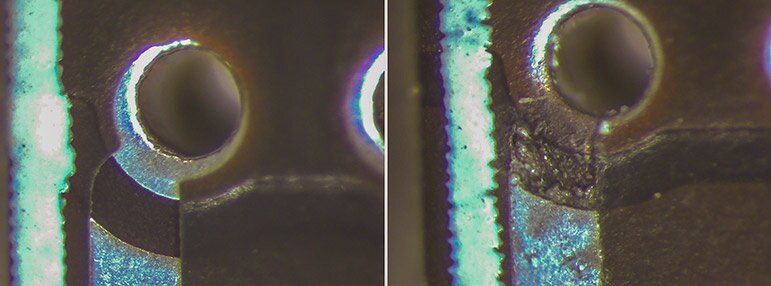Who Dropped The Ball? The Importance of Process Control
We recently investigated a pair of production defects that demonstrated the importance of material identification and process control. Two unrelated but similar instances of field failures, directly attributable to the introduction of materials that were not part of the normal production process, highlight the need to not only ‘say what you do’, but also ‘do what you say’ in terms of process control.
Story #1
We assisted a client who was experiencing field failures for automotive electronic assemblies. Our analysis indicated that electrochemical migration was occurring in an isolated area of the PCBA. One factor was a design/layout issue that resulted in a small gap between two nodes devoid of solder mask. The more significant factor was a discovery of high levels of Zinc Chloride and other conductive/corrosive residues associated with water-soluble flux at the site of the thermal event. The contamination was so severe that some assemblies were suffering flaming failures only moments after initial application of battery voltage.
The pattern of known affected units did not indicate that a contiguous, sequential run of product was contaminated; rather the units in question were more random in nature. Eventually, the source of contamination was traced to a specific operator that was acting outside of the documented process by mixing a more aggressive flux material with the standard rework flux to achieve more desirable results.
A solder mask gap between two closely spaced pads near a PTH component provides an opportunity for corrosive residue to cause problems.
Story #2
A similar situation impacted another client without such dramatic results. Field failures were analyzed and found to have high levels of ionic contamination typically associated with water soluble flux, despite the use of no-clean material in the process. When the dust settled and the truth came out, it was determined that an aggressive maintenance flux—used for cleaning the selective solder cone—was inadvertently introduced to the fluxing system. The material was then directly applied to the PCBAs in question, resulting in significant corrosion and electrochemical migration issues in the field.
The Common Factor: Contamination
In the first example, an operator was motivated by an increase in rework material being generated. Access to an improper material that was not part of the normal process allowed an operator to exercise improper judgement and use the material incorrectly.
In the second example, a material intended for use only during equipment maintenance was inadvertently introduced to the production process.
Maintaining Control of Your Production Environment
In both cases, lapses in control of non-production materials resulted in bad material reaching the customer. Both of these instances could have been avoided if management had been more proactive in identifying weaknesses in process control.
The silver lining in these two examples is that the contamination issues were severe enough that failure was relatively immediate and bad material could be detected and screened prior to reaching the end user.

